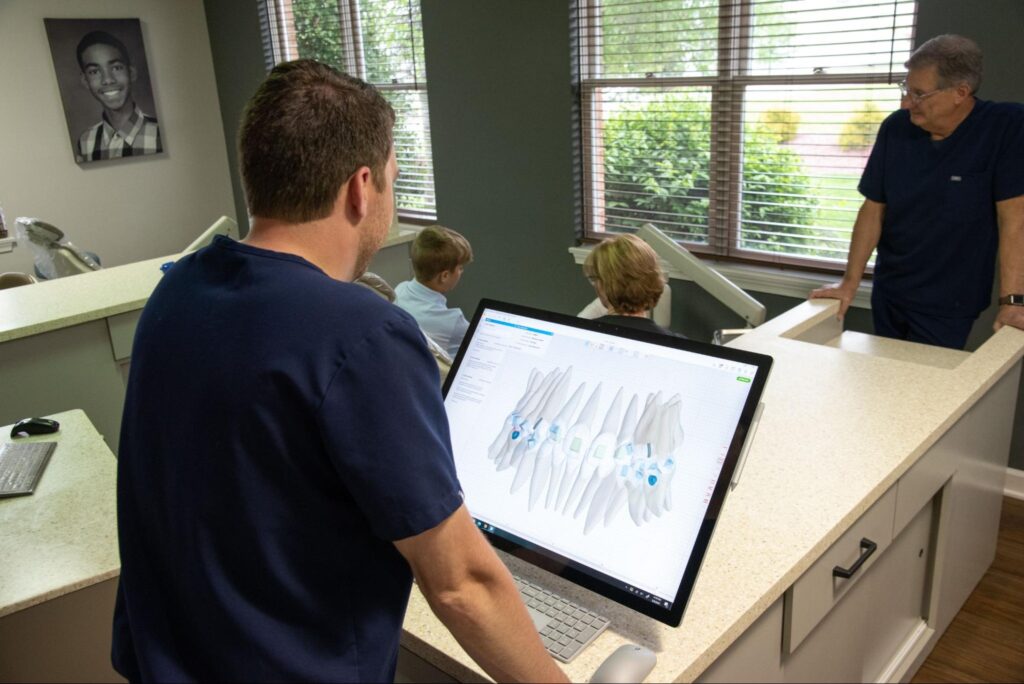Braces are a crucial component of orthodontic treatment, designed to help achieve healthy, beautiful smiles. These ingenious devices work by applying gentle, continuous pressure to the teeth, gradually guiding them into their ideal positions. Braces not only enhance the aesthetics of your smile but also improve your oral health by correcting bite issues and making it easier to maintain good dental hygiene. Let’s dive in and find out the elements that make up braces and explore how they work together to help you achieve the smile of your dreams.
Components of Braces
Braces consist of several components that work in harmony to guide your teeth into their proper positions:
Brackets
Brackets are small square-shaped attachments that are bonded directly to the front of each tooth. They can be made of metal or ceramic or even placed on the back of the teeth (lingual brackets). Metal brackets are the most common and durable, while ceramic brackets offer a more discreet appearance. Lingual brackets are virtually invisible, as they are placed on the inside of the teeth.
Archwire
The archwire is a thin, flexible wire that connects all the brackets and guides the movement of the teeth. It is periodically adjusted and tightened to apply the appropriate amount of pressure on the teeth, gradually shifting them into the desired positions.
Bands
Bands are metal rings that are typically placed around the molars. They provide a stable anchor point for the brackets and archwires, ensuring the proper force is applied to the teeth.
Elastics (Rubber Bands)
Elastics, or rubber bands, are used to correct bite issues and fine-tune the alignment of the teeth. They come in various sizes and configurations and are hooked onto the brackets in specific patterns as directed by your orthodontist. Wearing elastics as prescribed is crucial for achieving the best results.
Types of Braces
There are several types of braces available. Each has its own unique characteristics and benefits:
Traditional Metal Braces
These are the most common types of braces, known for their durability and effectiveness. Made of high-grade stainless steel, metal braces are strong enough to handle even the most complex orthodontic cases.
Ceramic Braces
Functionally, ceramic braces are similar to metal braces, yet they offer a subtler appearance. The brackets are made of a clear or tooth-colored ceramic material, which makes them less noticeable than metal.
Lingual Braces
Lingual braces are a type of braces that are placed on the inner side, making them almost unnoticeable to others. They are custom-made to fit the unique contours of your teeth and are a popular choice for adults who want to maintain a professional appearance during treatment.
Self-ligating Braces
Self-ligating braces use a specialized clip mechanism to secure the archwire rather than the traditional elastic ties. This design allows for fewer adjustments and can make oral hygiene easier, as there are fewer nooks and crannies for food and plaque to accumulate.
The Orthodontic Treatment Process
The journey to a perfect smile with braces involves several important steps:
Initial Consultation
During your first visit, Dr. Fred and Dr. Jeff will examine your teeth, jaws, and bite. They may take x-rays, photographs, and dental impressions to create a personalized treatment plan tailored to your unique needs.
Customization and Application
Once your treatment plan is finalized, it’s time to custom-make your braces and carefully attach them to your teeth. This process typically takes one to two hours and is generally painless.
Adjustment Period
As you progress through your treatment, you’ll need regular appointments for adjustments. During these appointments, the team at Alba Orthodontics will monitor your progress, make any necessary modifications to your braces, and provide you with guidance on caring for your teeth and braces.
Aftercare and Retainers
Once your braces have been removed, retainers will be provided to ensure your smile remains perfectly aligned. It is important to wear your retainers as instructed to prevent your teeth from moving back to their initial positions.
Common Questions About Braces
We understand that you may have many questions about life with braces. Here are some of the most common inquiries we receive:
Will braces be painful?
While some discomfort is normal, especially after adjustments, braces should not cause significant pain. Over-the-counter pain relievers and orthodontic wax can help manage any temporary discomfort.
How long will I need to wear braces?
Treatment duration varies depending on the complexity of your case, but most patients wear braces for 18-24 months.
How do I care for my braces?
Brush your teeth after every meal, floss daily (using threaders or a water flosser), and avoid hard, sticky, or sugary foods that can damage your braces.
Can I still play sports or musical instruments with braces?
Absolutely! You can get protective mouthguards for sports, and our team can also offer guidance on how to play musical instruments with braces.
We’re Here to Help
Ready to take the first step towards your perfect smile? Schedule a consultation with our friendly, experienced orthodontic team today. We’ll work with you to develop a personalized treatment plan that fits your unique needs, lifestyle, and goals. Your dream smile is closer than you think!





